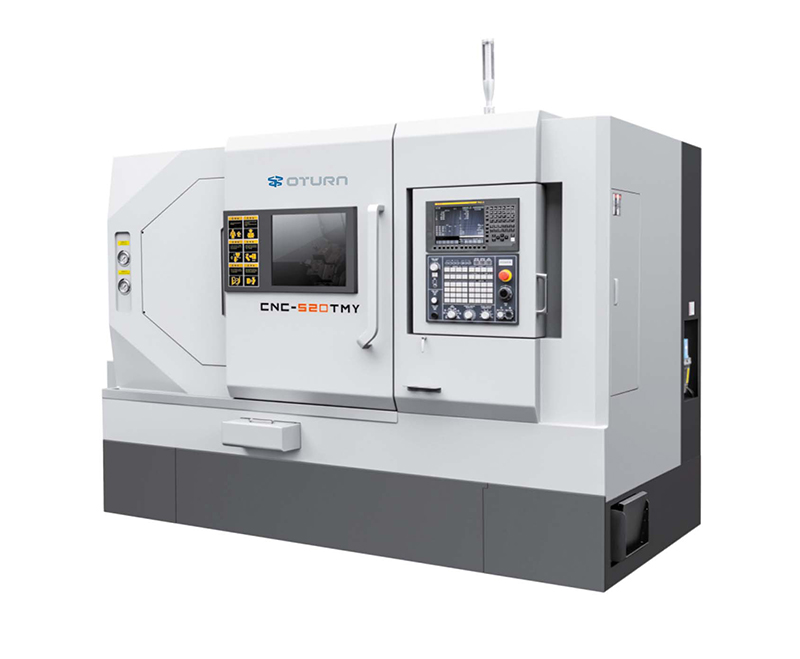The CNC turning and milling machine is an advanced mechanical processing equipment that can flexibly integrate turning and milling processes to meet diversified production needs and is widely used in the field of precision machinery manufacturing. Its main advantages are reflected in processing capacity, production scale adaptability, and product type diversity.
I. Processing capacity
1. Integrated processing of multiple processes improves efficiency
The CNC turning and milling machine perfectly combines turning and milling processes, greatly simplifying the process. For example, when processing complex shaft parts, it can not only complete the turning of the outer circle and inner hole of the shaft, but also use the milling function to perform high-precision processing on the keyway and plane features on the shaft. This integrated design significantly reduces the multiple clamping of the workpiece between different machine tools, improving the processing accuracy and production efficiency.
For disc parts with complex curved contours, the CNC turning and milling machine can complete the processing task at one time. During the processing process, the equipment first forms the basic contour of the part by turning, and then uses milling to refine the details, such as edge patterns, chamfers, and other complex shapes, to achieve a high-quality finished product output.
2. Wide range of material applicability
This type of composite processing equipment supports the processing of a variety of metal materials, including 45 steel, stainless steel, aluminum alloy, copper alloy, and other metals with a wide range of hardness. For different materials, the equipment adjusts cutting parameters such as cutting speed, feed rate, and tool selection to ensure stable and efficient processing.
In addition, the CNC milling machine can also be used for non-metallic material processing, such as plastics, plexiglass, etc., to meet the diverse requirements of cost and performance of specific parts. This provides more possibilities for manufacturing diversified products with special properties.
II. Production scale advantage
1. Ideal choice for small batch diversified production
For small batch production, the milling machine shows great advantages. Its flexible processing program switching and tool replacement capabilities make the production conversion of parts of different specifications fast and efficient. It is especially suitable for small processing plants or customized orders. If you need to produce dozens of multi-variety parts, there is no need to replace complex molds or undergo long-term debugging, which greatly saves time and cost.
The high-precision control system ensures that each part meets strict dimensional and surface quality standards, and adapts to the needs of industries such as aerospace and precision instruments that have high requirements for part quality.
2. High efficiency and stability to meet the needs of mass production
The CNC milling machine can also meet the needs of mass production. Combined with the automatic loading and unloading device, the equipment can achieve 24-hour uninterrupted operation, greatly improving the processing capacity. For example, in the batch processing of parts in the automotive industry, the equipment ensures the dimensional consistency and processing accuracy between parts and guarantees the assembly quality.
Through the continuous optimization of the processing program and tool path, the empty stroke and invalid cutting are reduced, the production efficiency is further improved, the unit processing cost is reduced, and efficient and intelligent production management is achieved.
III. Processing capabilities of typical product types
1. High-precision processing of shaft parts
The CNC milling machine is suitable for processing various shaft parts, including outer circle, inner hole, taper turning, keyway, and thread milling. The equipment is equipped with auxiliary devices such as the center frame, which can effectively prevent the deformation of shaft parts during processing and ensure processing accuracy.
In addition, the equipment can complete a variety of processing processes, such as chamfering, grooving, and drilling at both ends of shaft parts to meet different design requirements, such as the high requirements for size and assembly accuracy of key parts, such as automobile engine crankshafts.
2. Diverse and complex processing of disc parts
For disc parts, the processing content includes turning of the outer circle and inner hole, as well as milling of the surface, such as the sealing surface and flow channel structure processing of the valve disc. The CNC turning center makes full use of the advantages of turning and milling to achieve fine milling of the gap between the hub spokes and ensure the structural strength and appearance quality.
At the same time, chamfering and drilling the edges of disc parts not only facilitates subsequent assembly but also improves the safety and use experience of the product, such as the processing of mounting screw holes and chamfer protection of the motor end cover.
In summary, the turning and milling compound processing machine is helping all walks of life to efficiently complete the processing and production of complex parts with its advantages of multi-process integration, high precision, and multi-category adaptation. If you need to improve equipment automation and processing efficiency, welcome to choose OTURN. We are committed to providing customers with high-quality CNC turning and milling compound processing solutions to help you continuously improve your productivity.
Post time: Aug-01-2025








